#valentini puffer
Explore tagged Tumblr posts
Text

he has such beautiful eyeshadow
198 notes
·
View notes
Text

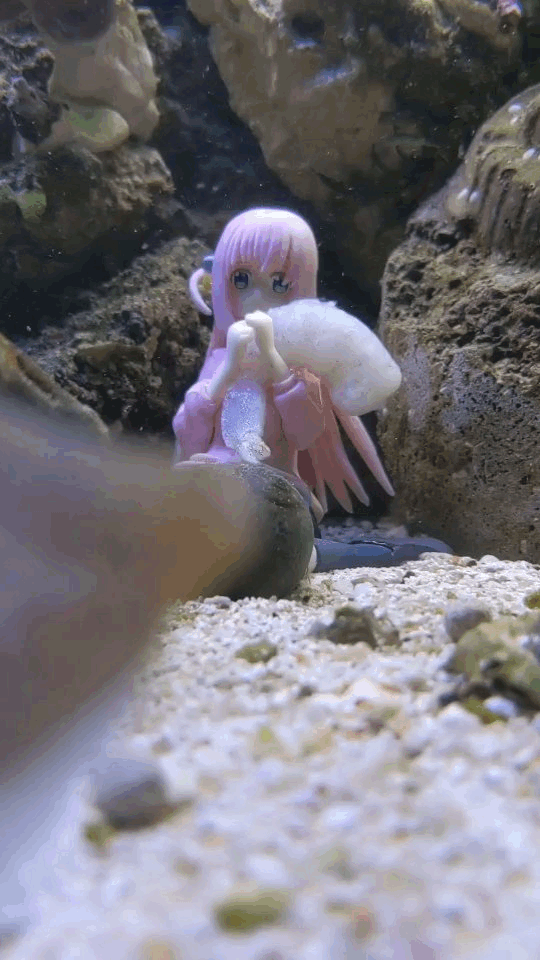

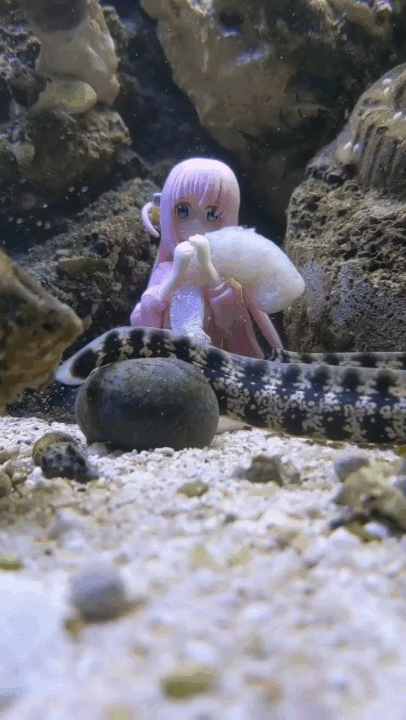

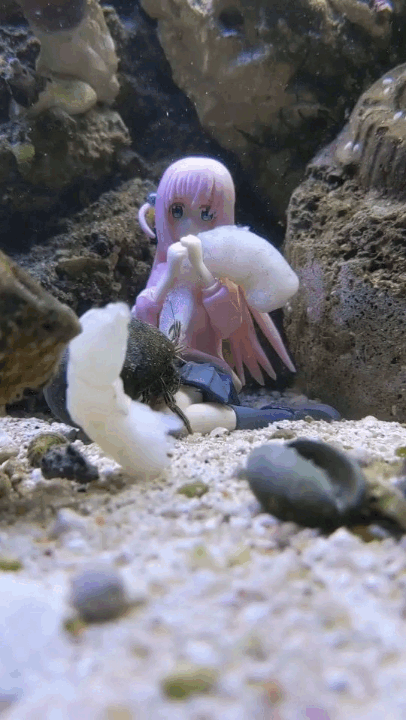


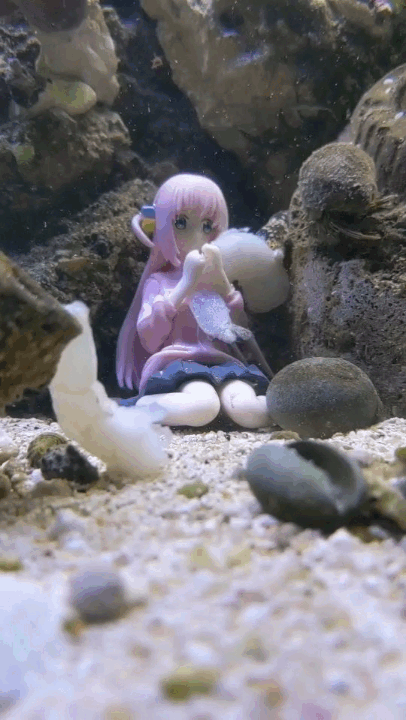
Bocchi Shrimp Offering To Hermit crab God and Moray eel God and Valentini sharpnose Puffer God and nobody really wants it so they all beat The Fuck out of her
8K notes
·
View notes
Text
Its been a while since i made a post about fish and their biology, so here is today's wet beasts, THE PUFFERFISH also known as the ballonfish, puffer fish are their own own family scientifically known as "Tetraodontidae!" They are morphologically similar to the closely related porcupinefish, which have large external spines, unlike their cousins thinner and more prittle spikes
And Today i have two species of puffer that i adore and i want to share with you
One of em is the
Valentin's sharpnose puffer


Also known as the saddled puffer, because he looks like he has a little saddle on his silly little back
His binomial name is Canthigaster valentini
He is in the genus Canthigaster (seen in its sciency name)
This badboy lives in very complex social groups that kinda feel like harems..! The dom male or female has a bunch of other fish to mate with, they are also kinda territorial and really like their personal space!
While in the harem mood lets talk about their eggs and larvae
Their eggs range in size between 0.68 and 0.72 mm in diameter, making them some of the smallest in the family Tetraodontidae! (So small :'3)
The eggs are spherical with nine radial layers, the outermost layer possessing strong cleaning properties helping them avoid infections, even fish respect their personal hygiene.
Lets move on to the other star of today's wet beast THE WONDEROUS LONG SPINED PORCUPINEFISH
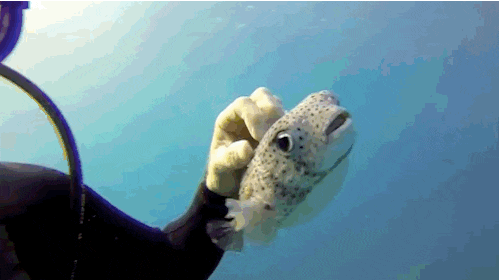

This cute little fellow is also known as the freckled porcupinefish because of its little spots all over its face!
They are found over the muddy sea bottom, in estuaries, in lagoons or on coral and rocky reefs around the world in tropical and subtropical seas!
Their are on the genus Diodon and their fancy biology name is Diodon holocanthus!
A fun fact! They spawn on the surface of the water at dawn and or dusk!
They are in fact both poisonous and venomous, so i would avoid touching them, but looking at their cuteness form afar is really great on its own!
#yeah :)#essay#marine science#marine animal#marine animals#marine biology#marine life#PUFFERFISH#pufferfish#this took way to long#i love fish so mucj
77 notes
·
View notes
Text
The saddled sharpnosed puffer
C. valentini, the saddled or black-saddled, banded, striped, or Valentini's pufferfish, is the most often traded member of a genus known as the sharpnose pufferfishes or tobies. Sharpnose puffers are named so, because their snouts are pointed for selective feeding, and the gut contents of Canthigaster include varied small items of snipped off animal and plant material. This petite species grows only to 11 centimeters at the longest. or about 4 inches, and the species is most typically closer to 8 centimeters or 3 inches long.
C. valentini inhabits reef and lagoon habitats, as far west as the Indian Ocean coast of Africa, to as far east as the Tuamotos archipelago. This species is also recorded in mangrove environments, where it is associated with Rhizophora mangle, and may in fact be common in such habitat. Juvenile C. valentini are found only in particularly shallow and sheltered envirinments, whereas the older fish of the same species, have much broader preferences of habitat.
With their unusual looks and peculiar swimming mode, and their great personalities, the pufferfishes have found their way into the hearts of numerous aquarists. Other than the basal diodontids, or porcupine fishes, all pufferfishes belong to a subclade called Tetraodontidae. Tetraodontid puffers tend to have only a few external characters usetul to taxonomists, and a number of puffer genera in common use today, were formerly lumped into Tetraodon itself.
Puffers are closely related to the pelagic ocean sunfishes, or molids, the balistoids or triggerfishes, and the boxfishes or ostracoids. These fishes together comprise the tetraodontiform clade, which is marked by tendencies of morphological reduction, simplification, and loss of osteological elements. Puffers and molids share faces that are unusually modified to form a beak-like structure, whereas balistoids and boxfishes possess individual teeth protruding from sockets in their jaws. Pufferfishes also possess dermal spines, the distribution of which on the body, varies between the pufferfish species, and they are most developed in the diodontid puffer clade.
Puffers alone are able to inflate their bodies by a rapid intake of seawater, making themselves too large and difficultly shaped for predators to handle. Although only pufferfishes can inflate in this way, their ability to do so is because their ancestors had already lost their pelvis and pleural ribs. Some other tetraodontiforms can alter the external shape of their bodies, by moving their pelvis, although they do not inflate like the members of the diodontid and tetraodontid clade.
Most species of pufferfish are found in marine environments, but many species are present in estuaries and freshwaters. Marine pufferfishes are present at depths beyond 350 meters deep, and a few species of pufferfish are pelagic. But most marine pufferfish inhabit shallow, tropical seas, and these are the species exported for saltwater aquarium retail The appealing C. valentini is perhaps the most commonly traded of these pufferfishes today.
Unlike typical pufferfishes, Canthigaster have unusually narrow bodies, and fish of this genus are not as well able to self-inflate, as are more typical pufferfish species. Instead their defence relies on potent toxins that are present within their tissues. People have actually died after attempting to eat pufferfish, a phenomenon that is known medically as tetrodotoxin poisoning. In addition to the notorious tetrodotoxin, C. valentini possesses saxitoxins, and both are concentrated primarily in their skins and ovaries, but also in other tissues.
Canthigaster puffers have toxic eggs and larvae, and they remain poisonous to eat when they become adults. Their bright coloration in fact advertises their toxicity, informing predators that the puffer is dangerous to consume. Both juvenile and adult confidently swim over open sand, out in the open, being quite immune to predation. High toxicity arguably affords C. valentini its bold and inquisitive nature, which is beloved to so many aquarists. These diurnal fish practice courtship and spawning throughout the day, and there is no postpartum care of their eggs by either parent fish.
C. valentini have social and mating systems, in which both the female fish guard territories, and the males have harems of females. Female C. valentini chase away other females, whilst the territories of the mature males monopolise their visiting access to a few females. Because C. valentini is so dangeously toxic when eaten, another tetraodontiform species, the boxfish Paraluteres prionurus, has evolved to mimic C. valentini, in order to convince potential predators not to attack. Aquarists, too, might easily confuse these two species, which are so similar that the boxfish is sometimes mislabelled as the puffer. Some juvenile groupers also imitate the toxic C. valentini, and other members of its genus.
Because of its small size, some aquarists have attempted to maintain C. valentini in aquariums with live corals, and other sessile and motile benthic animals. This cannot be encouraged for the simple reason that wild C. valentini and its relatives, consume stony coral polyps as a part of their wide, natural diet. Although at least some of the tissues might be ingested incidentally, when nipping at organisms on living corals, there is no reason C. valentini should not be expected to purposefully bite corals themselves, and this is reported to occur in aquariums.
The gut contents of wild C. valentini demonstrate that its dietary spectrum is broad, including both plants and animals, and different Canthigaster species tend to consume the same categories of food, though they do so in differing proportions, so that the diet of one Canthigaster species bears relevance to that of another, without it matching. When it is compared to some other Cantnigaster puffers, C. valentini shows a particular preference towards nipping fleshy red macroalgae and tunicates, at least in Micronesia where members of the sharpnosed pufferfish guild show niche partitioning.
The organisms nipped by Canthigaster often have chemical defences of their own, which explains why these pufferfish merely nip a little off a growing animal or plant, and then moves along insteat of consuming them in bulk. Such feeding behavior in grazing and browsing animals, helps them by preventing poisoning by any one food source in great ammounts, wether the animals in question are sharpnosed pufferfish, or big, herbivorous land mammals such as elephants.
Members of the Canthigaster genus are known to nip at algae, big foraminifera, and sessile fauna, but also to consume motile benthic animals, such as gastropods, arthropods, and even echinoderms. Contrary to some claims, wild gut contents indicate the sharpnose puffers do not attack other fish in order to devour their scales or fins, a feeding behaviour reported in certain other tetraodontids. C. valentini are often housed with other fish species without incidents, it is true their territorial nature can cause some C. valentini be a little nippy to other species.
The breadth of their diet makes Canthigaster puffers easy to feed in the home aquarium. Foods of both animal and vegetable origin must be given to these fishes, and their diet ought to be varied for the sake of their health. C. valentini are territorial, with their territories centered upon a crevice in a hard substrate, and as might be expected, this species can be pugnacious to their own and other Canthigaster species. Maintaining this species in groups is definitely not recommended.
C. valentini are a small pufferfish suited to a 30 gallon aquarium, making then easier to accommodate than larger puffer species, which might be purchased young by the unsuspecting aquarist, then subsequently outgrow their tanks. But a lot of information about this species with other tankmates is contradictory, which is partly because of personality and habit variation between the individuals, and because their territoriality increases with age, and it is females that are most guarded, at least towards their own or similar species.
#saddled pufferfish#black-saddled pufferfish#Valentini's pufferfish#barred pufferfish#striped pufferfish#Canthigaster valentini#sharpnosed pufferfishes#tobies#misunderstood fishes#marine pufferfishes
0 notes
Photo
Ray is a swordfish just like Kai, and Maya and Nya are both oarfish. Although I'm debating if the entire Jiang family should be swordfish merpeople
Dr Julien is a Valentini pufferfish and Echo a black spotted puffer

MerNinja, Jay’s Real Parents edition
Libber is an electric catfish just like her son while Cliff Gordon AKA Clouse is none other than a Portuguese man-o-war
Jay got his element and appearance from his mom and thankfully he doesn’t sting. At least not nearly as bad as Clouse’s many tentacles
13 notes
·
View notes
Text
Re-did my saltwater aquariums aquascape and am feeling really pleased with it! It definitely has a lot of growing to do but the fish seem to like the new layout, and I think I will enjoy it being much easier to clean. Only coral that is upset is my Xenia, and it'll be back in full force before I even miss it lol.
Oh, and don't worry about the dottybacks fins...the dumb dumb loves shoving himself through small holes hunting worms and regularly rips them. I just make sure to keep things extra clean for his healing.
#fish#reef#reeflife#reefblr#saltwater#aquarium#saltwater aquarium#coral#puffer#valentini puffer#springeri dottyback#flame hawkfish#dottyback#hawkfish#fishblr
25 notes
·
View notes
Photo



Valentin's sharpnose puffer (Canthigaster valentini)
Valentin's sharpnose puffer is a demersal marine fish belonging to the family Tetraodontidae.The Saddled puffer is a small sized fish which grows up to 11 cm.It is widely distributed throughout the tropical and subtropical waters of the Indian Ocean, Red Sea included, and until the oceanic islands of the Pacific Ocean.It inhabits rocky and coral reefs, lagoons and external reef until 55 m. Canthigaster valentini has a diurnal activity.Canthigaster valentini is omnivorous, it feeds on filamentous green and red algae, tunicates, and on smaller amounts of corals, bryozoans, polychaetes, echinoderms, mollusks, and brown and coralline red algae.Valentinni's sharpnose puffer is highly poisonous to eat.
photo credits: JennyHuang, Karelj, Haplochromis
#Valentin's sharpnose puffer#Canthigaster valentini#fish#zoology#biology#biodiversity#science#wildlife#nature#animals#cool critters
626 notes
·
View notes
Note
how are rex and ves related? is ves just white passing or…?
lol nah he’s just white. they’re not Actually blood relatives, although they were cloned by the same person and their samples were contaminated with dna from the same alien organism, so one could probably argue that angle? however they regard eachother as siblings regardless because they were best friends growing up and neither really had much other family, so they adopted eachother.


here’s some oldish concept art and some fun facts about these two!
- rex is older by a couple of months due to complications in ves’ development, even though maestro started working on both of them at the same time
- rex’s unusual traits are almost all body modifications that she chose to seek out - ves, however, was just. born like that. with his blue tongue and red eyes and weird sharky teeth. he used to hate them, because other kids made fun of him - but rex thought it was really cool.
- they’re each loosely inspired by aquatic animals! rex’s face tattoos and the shape of her helmet are inspired by the valentini puffer, and her color scheme kind of based off fairy wrasse. ves is based on a green moray eel and while not aquatic specifically, his neck tattoos are also loosely inspired by this post about a specific parasite that infects chameleons (warning for parasites and imagery of a dead animal, although not graphic)
- they are both transgender . the ol switcharoo
15 notes
·
View notes
Photo

In case anyone wondered what my puffer looks like
1 note
·
View note
Text

Tetraodontidae - Canthigaster valentini (Saddled Puffer).jpeg
10 notes
·
View notes
Text

freckle and scoot!
#valentini puffer#cleaner wrasse#freckle the puffer#scoot the cleaner wrasse#aquablr#fishblr#marine biology#my pets
21 notes
·
View notes
Text
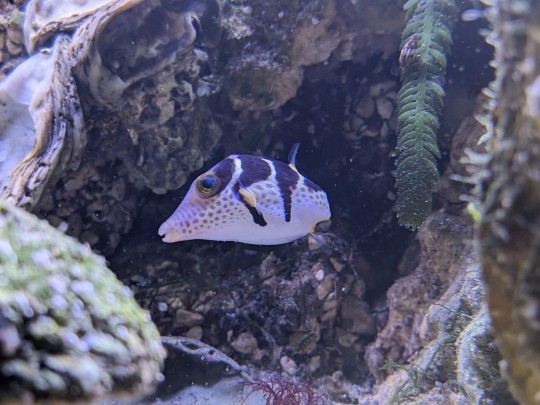


My reef crew: Šarko (Valentini Toby puffer), Thugizzle (Lawnmower Blenny), and Igorrrr (Snowflake Moray). Beautiful set of idiots.
#marine biology#fishkeeping#aquarium#reef tank#Šarko and Thugizzle were recent acquisitions from a rehoming Facebook group i have learned i dont need to buy dick for my tanks#when i can trade frags and macros
18 notes
·
View notes
Video
Canthigaster valentini Black-saddle toby #marineexplorer by John Turnbull Via Flickr: This little fish may look cute, but it is poisonous like other puffers and toadfish in this family. This particular species only grows to 11 cm long and this individual was only around 5 cm.
38 notes
·
View notes
Text
In other fish related news
While I can still talk to you guys all in one place.
Mike and are trying to decide what to do with the now empty 55 gallon.
We’re either taking the plunge and going FOWLR (with a definite Toby or Valentini puffer and other salty friends)
OR
...goldies???? Maybe??
We really wanna try our hand at saltwater in a medium sized system before we go full hog some day and do a 150. I know larger systems are easier and more forgiving but mike and I aren’t sure we want to invest in a giant system if it’s not sustainable for us or to our liking. I’m very interested in the fish we’d be able to keep (sharpnose puffs, clowns, etc) and gaining experience with managing some of the new challenges. Mike wants to build a sump.
However, saltwater is going to be an expensive upgrade for the tank (see: building sump tank, actual pump, protein skimmer, live rock, powerhead, even just more salt than we go through with Burd, etc) and it’s going to be more delicate and time consuming. There’s a blink of a Chance we might be moving in July and salty friends would not...like that. Plus, if we’re truly gonna pull the trigger on buying a house, the expense is not wise at this time.
If we’re being honest with ourselves we haven’t been as stringent about water changes as we used to be. The fact burd’s tank is rather under stocked and Burd is the GSP equivalent of a tank apparently has worked in our favor. We’re going to have to step up our game with either option but it feels like goldies might be easier???
As for goldies...cute water puppies! We’d only have to switch around some tank decor and get rid of sand, and maybe upgrade to a canister filter. Freshwater is familiar and easier. Plus more fish that are personable and bond with us!
BUT mike is super concerned with the health/motility of fancy goldies. Most varieties are straight out for us, except maybe orandas, ryukins, or fantails. Ranchu’s maaaaybe. We’d probably only be getting two. Also he care and keeping if a fish with a wen scares me a little??? Hole in head disease??? Fungus??? Eep???
Anyone care to share thoughts or message me? Particularly if you’ve had both at one time?? Cough cough @kai-ni ??? @kaleighbytheway didn’t you have goldies or have them now? B
6 notes
·
View notes
Photo

Valentini Puffer #thehiddenreef #valentinipuffer (at The Hidden Reef, Inc) https://www.instagram.com/p/CEKKh1hpIXB/?igshid=vmgldrp1jamj
0 notes
Text
i miss my pea puffers. i wish puffs weren’t so prone to IPs and were a lil easier to keep a good supply of live food for.... they’re such good fish. someday when i’ve got my own place i wanna get a big ol tank for one of the bigger species. maybe brackish or even salt if i’m feeling spicy. valentini puffers are high on my dream animal list but porcupines are very cute too.
2 notes
·
View notes
